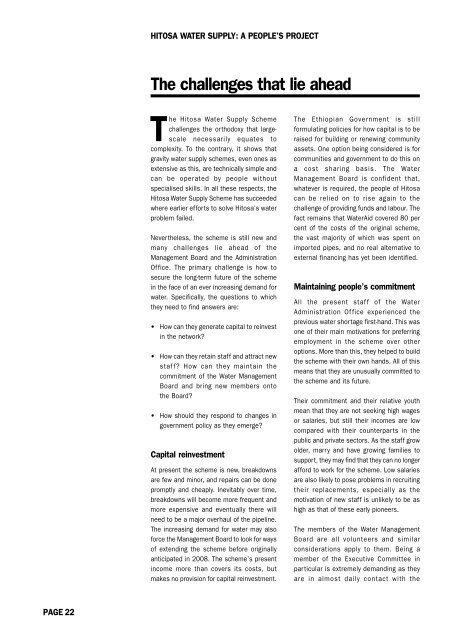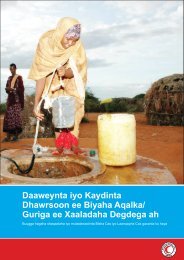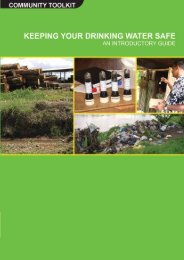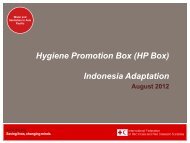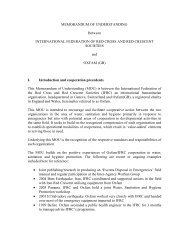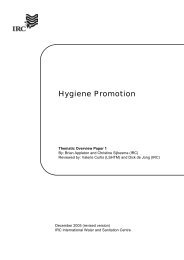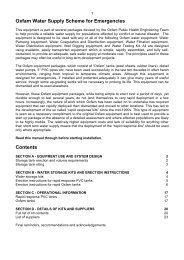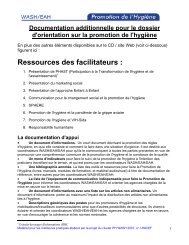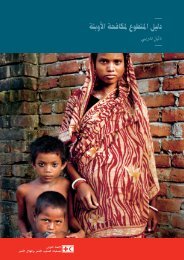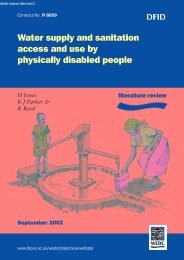Hitosa water supply: a people's project - watsanmissionassistant
Hitosa water supply: a people's project - watsanmissionassistant
Hitosa water supply: a people's project - watsanmissionassistant
You also want an ePaper? Increase the reach of your titles
YUMPU automatically turns print PDFs into web optimized ePapers that Google loves.
HITOSA WATER SUPPLY: A PEOPLE’S PROJECTThe challenges that lie aheadThe <strong>Hitosa</strong> Water Supply Schemechallenges the orthodoxy that largescalenecessarily equates tocomplexity. To the contrary, it shows thatgravity <strong>water</strong> <strong>supply</strong> schemes, even ones asextensive as this, are technically simple andcan be operated by people withoutspecialised skills. In all these respects, the<strong>Hitosa</strong> Water Supply Scheme has succeededwhere earlier efforts to solve <strong>Hitosa</strong>’s <strong>water</strong>problem failed.Nevertheless, the scheme is still new andmany challenges lie ahead of theManagement Board and the AdministrationOffice. The primary challenge is how tosecure the long-term future of the schemein the face of an ever increasing demand for<strong>water</strong>. Specifically, the questions to whichthey need to find answers are:• How can they generate capital to reinvestin the network?• How can they retain staff and attract newstaff? How can they maintain thecommitment of the Water ManagementBoard and bring new members ontothe Board?• How should they respond to changes ingovernment policy as they emerge?Capital reinvestmentAt present the scheme is new, breakdownsare few and minor, and repairs can be donepromptly and cheaply. Inevitably over time,breakdowns will become more frequent andmore expensive and eventually there willneed to be a major overhaul of the pipeline.The increasing demand for <strong>water</strong> may alsoforce the Management Board to look for waysof extending the scheme before originallyanticipated in 2008. The scheme’s presentincome more than covers its costs, butmakes no provision for capital reinvestment.The Ethiopian Government is stillformulating policies for how capital is to beraised for building or renewing communityassets. One option being considered is forcommunities and government to do this ona cost sharing basis. The WaterManagement Board is confident that,whatever is required, the people of <strong>Hitosa</strong>can be relied on to rise again to thechallenge of providing funds and labour. Thefact remains that WaterAid covered 80 percent of the costs of the original scheme,the vast majority of which was spent onimported pipes, and no real alternative toexternal financing has yet been identified.Maintaining people’s commitmentAll the present staff of the WaterAdministration Office experienced theprevious <strong>water</strong> shortage first-hand. This wasone of their main motivations for preferringemployment in the scheme over otheroptions. More than this, they helped to buildthe scheme with their own hands. All of thismeans that they are unusually committed tothe scheme and its future.Their commitment and their relative youthmean that they are not seeking high wagesor salaries, but still their incomes are lowcompared with their counterparts in thepublic and private sectors. As the staff growolder, marry and have growing families tosupport, they may find that they can no longerafford to work for the scheme. Low salariesare also likely to pose problems in recruitingtheir replacements, especially as themotivation of new staff is unlikely to be ashigh as that of these early pioneers.The members of the Water ManagementBoard are all volunteers and similarconsiderations apply to them. Being amember of the Executive Committee inparticular is extremely demanding as theyare in almost daily contact with thePAGE 22


